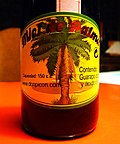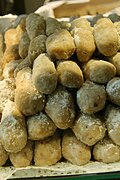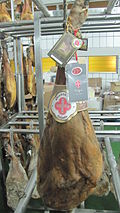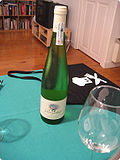| Name | Image | Region | Type | Description |
|---|
| Arroz a la cubana ("Cuban-style rice") |  | Canary Islands | rice dish | a dish consisting of rice, a fried egg, a fried banana and tomato sauce. |
| Arròs negre/arroz negro or paella negra ("black rice", "black paella") |  | Valencian Community and Catalonia | rice dish | a cuttlefish (or squid) and rice dish very similar to seafood paella. It is made with cephalopod ink, cuttlefish or squid, rice, garlic, green cubanelle peppers, sweet paprika, olive oil and seafood broth. |
| Boquerones en vinagre |  | everywhere | fish dish | Anchovies marinated in vinegar and seasoned with garlic and parsley |
| Butifarra amb mongetes |  | Catalonia | bean dish | a dish consisting of a cooked botifarra and dry beans. |
| Calamares en su tinta [ es ] |  | everywhere | fish dish | calamari cooked in their own ink, often served with rice |
| Callos a la madrileña [ es ] |  | Madrid | meat dish | an offal (tripe) dish |
| Carcamusas |  | Province of Toledo | meat dish | a dish consisting of cooked lean meat and season vegetables. |
| Chicharrón (Beef Scratchings) |  | Andalusia | pork dish | a dish made of fried pork rinds. It is sometimes made from chicken, mutton, or beef. |
| Chireta, gireta or girella |  | Aragonese and Catalan Pyrenees | pudding | a type of haggis with rice made in some Pyrenean regions. |
| Cuchifritos or cochifritos |  | Castilla-La Mancha, Castilla y León and Extremadura | meat dish | a fried lamb or goat meat along with olive oil, garlic, vinegar, basil, rosemary, bay leaves, and spearmint. |
| Escabeche |  | everywhere | fish dish | referring to both a dish of poached or fried fish, and not only fish (escabeche of chicken, rabbit or pork is common in Spain) that is marinated in an acidic mixture before serving, and to the marinade itself. |
| Escalivada |  | Catalonia | salad | a salad that consists of several types of grilled vegetables, such as eggplants, spicy red peppers, red tomato and sweet onions. Once well cooked on the grill, those vegetables are peeled or sliced in strips, the seeds removed, and seasoned with olive oil and salt, and sometimes with garlic as well. |
| Esqueixada |  | Catalonia | salad | a salad that consists of shredded salt cod, tomatoes, onions, olive oil and vinegar, salt, and sometimes a garnish of olives or hard-boiled eggs. |
| Fideuà or Fideuada |  | Valencian Community | noodle dish | a noodle dish with a similar recipe to paella, usually made with seafood and fish, and optionally served with alioli sauce (garlic and olive oil sauce). |
| Gachas ("porridge") |  | Andalusia | staple dish | an ancestral basic dish from central and southern Spain. Its main ingredients are flour, water, olive oil, garlic and salt. |
| Gambas al ajillo [ es ] |  | everywhere | seafood | peeled shrimps cooked in a clay casserole with oil and garlic |
| Gazpacho manchego |  | Castilla-La Mancha | staple dish | pieces of torta de Gazpacho, also known as tight candles, a type of flat bread, mixed with a quail, pigeon, hare or rabbit stew. |
| Huevos rotos ("broken eggs") |  | everywhere | egg dish | fried eggs accompanied by French fries and some kind of meat (ham, bacon or a sausage like chorizo, longaniza or chistorra). |
| Migas ("crumbs") |  | Castilla–La Mancha, Andalusia, Aragon, Murcia, Castile and León, Extremadura | bread dish | small toasted pieces of bread (crumbs) with olive oil, garlic and bacon, mainly. |
| Paella |  | Valencia | rice dish | a saffron rice dish traditionally made with chicken, rabbit, and butter beans (Paella Valenciana). |
| Patatas bravas ("fierce potatoes") |  | Everywhere | potato dish | cube-shaped fries with salsa brava, a spicy sauce. |
| Patatas revolconas [ es ] |  | Castile and León | potato dish | mashed potatoes with paprika, often accompanied by torreznos |
| Ropa vieja ("old clothes") |  | Canary Islands | meat dish | shredded flank steak in a tomato sauce base |
| Tortilla de patata (Spanish tortilla, "potatoe omelette") |  | everywhere | egg dish | an omelette with potatoes and onion (optionally without it), often served as a tapa. |
| Zarangollo |  | Region of Murcia | egg dish | a Murcian dish consisting of scrambled eggs with zucchini, onion, and occasionally potatoes. |
























































































































